The most common confused questions I hear on identification are about elderberries and the water hemlock. Had I not students such a confusion would have never occurred to me as to me the two species don’t look alike at all. Generally said elderberry fruit is edible, the entire water hemlock is deadly. Indeed, many call water hemlock the most deadly plant in North America. Learning to identify the two is very important.
The Elderberry, Sambucus canadensis, is a shrub with bark, to ten feet or more. Woody. Its blossom is a dense flattop. It produces, locally, black berries about BB size. It has opposite compound leaves, feathery. Most of the veins on the leaf either fade after leaving the midrib or terminate at the tip of the teeth, not in the notches. If you have a #10 magnifying glass you can see tiny veins terminating at the tips of the teeth. Occasionally an elderberry vein will terminate at a notch, but it is uncommon.
The Water Hemlock is herbaceous, two to seven feet. It has a green main stem with purple splotches, or is entirely dusky purple particularly when young. The sectioned, hollow stem has vertical grooves on the outside. It produces a fire cracker-like explosion white blossom that made up of many smaller umbrella-like blossoms. Those produce seeds, not fruit. It has alternating, compound leaves, coarse, toothy. On individual leaves most, not all, but most of the veins clearly terminate between the teeth, in the notches.
Let’s also talk about habitat. Both elderberries and water hemlock are associated with water. But there are some differences: Elderberries can tolerate more dry areas and Water Hemlock can grow in water. If you are in a dry area that is dry most of the time and you think you have one or the other it will probably be an elderberry. If you have damp ground it can be either. If it is standing water most of the time it will probably be water hemlock. Season also counts. Elderberries are year round locally. Water Hemlock can die back in the winter.
Now a closer look: Elderberries are shrubs. They are woody. They have bark. The bark is green and smooth when very young with occasional white dots that are actually lenticels, which is one way the plant exchanges gasses. With time and height the elderberry develops a familiar looking bark, smooth and brown. Now the lenticels are corky lumps seen at left. On much older plants the bark will become vertically furrowed. The inner core of the trunk and branches — the pith — is soft and can be easily reamed out. Not a long-lived plant, just a few years, it can grow to about four inches through. When it dies and dries it leaves a vertical standing small dead tree. The dead wood breaks easily and burns well.
The Water Hemlock is herbaceous, read not woody. It does not have bark. It has nodes, which are swellings where leaves attach or used to attach. The main stem has vertical groves in it and is hollow. It is often streaked with purple, or is splotched with purple. It is usually at least purple at the nodes and sometimes young plants can be entirely dusky purple. Ocassionally the entire older plant will be purple. A stem that is an inch through would be a large water hemlock. The plant is hairless. When crushed it can have a pleasant liquorish or anise scent, or it can also smell like mouse urine. Remember it is deadly and can kill in virtually minutes. The toxicity decreases vertically with the roots the most toxic and the seeds the least. Taste is not a warning sign in that those who have eaten the roots raw or cooked said they were flavorful and very enjoyable. Depending upon the size of the individual, the amount consumed and which parts consumed death will occur in 15 minutes to a little over two hours. This is not the hemlock given to Socrates which was a gentle species. This species produces severe pain and convulsions, torturing its victim horribly until death.
The leaves of both species are different, not only from a distance but close up as well. The veins of the elderberry leaf either fade as they reach the edge of the leaf or terminate at the tip of the teeth. You may need a small magnifying class to see that. The veins are most prominent as they leave the light-colored midrib. Also note that the teeth are quite small, like the edge of a small serrated steak knife.
The veins of the water hemlock are quite different. The veins of the water hemlock clearly terminate BETWEEN the larger teeth of the leaf. See arrows to right. There is no ambiguity. The veins end between the teeth. Even when a vein splits the split ends go to the notches, not to the tips of the leaf. There may be an occasional exception but the trend of the majority is very clear. You will note that while each species’ leaf has an acute tip (pointed) the elderberry leaf is round near the tip whereas the water hemlock leaf is not.
The elderberry is not without its dangers as well. The wood is toxic and has poisoned folks who have made whistles out of the green wood. Unripe elderberry fruit is toxic and the ripe fruit bothers some people. The ripe fruit is better used dried, cooked or made into wine or jelly than consumed raw.
Lastly, the “hemlock” tree is a totally different species and issue. To read more about different colored elderberries, click here.

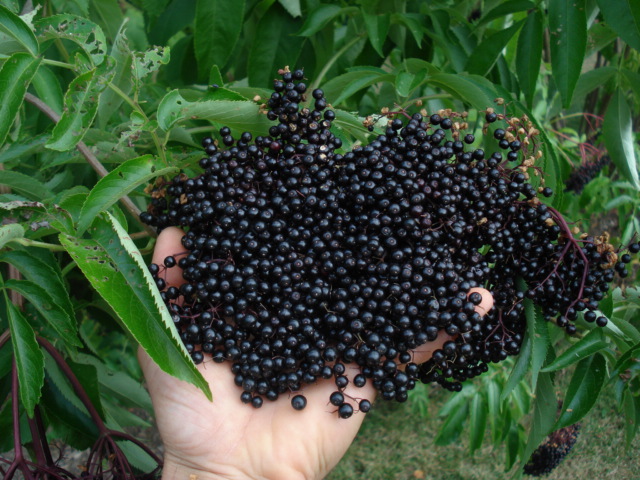
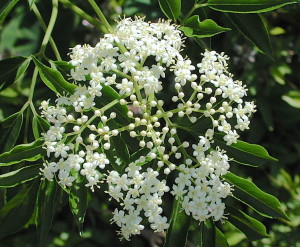
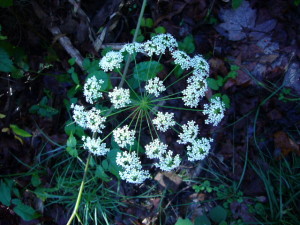
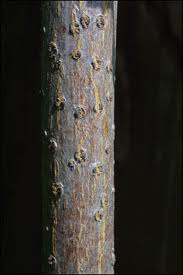
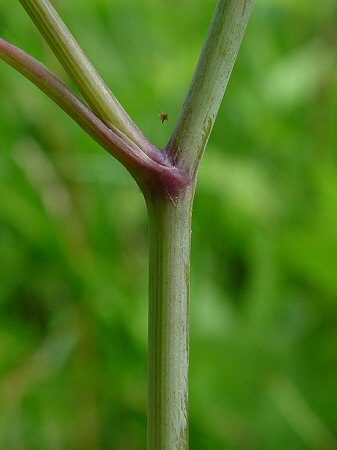
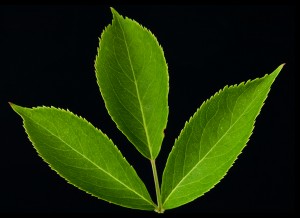
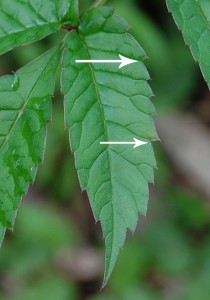

Green,
That’s the best description I’ve ever seen and certainly makes it clear for me. I just found what I thought might be Water Hemlock and sure enough, after reading your blog – that’s what it be. Thanks.
Hank Fannin
Hey hank this is josh, the tall fellow that took you’re class last year the friend of Craig (in the wheel chair).funny seeing you on this website.let me know of your next class I go to church with the owner of that property. And Deane do you have a post on swamp titi? I’m trying to identify h this small shrub and haven’t seen it blossom but it grows right near elderberry just not as tall, looks very similar though.
josh yingling may I ask what is this ” swamp titi ” you speak of ? I love the Eleder Lady flower!
hi-
i am always confused with wild fennel, wild dill, and water hemlock because of the purple stems and flower heads-
re-elderberry:
by the way, my mother is Danish, and we grew up with a great amazing Scandinavian traditional use of elderberries: elderberry soup!! it was used as a warm savory dish with a dollop of sour cream–so a bit like Russian Borsht in look and consistency. it was especially good for colds and flus.
Could you share the Elderberries soup recipe please
Holundersuppe mit Grießklößchen
I found this: looks just lovely 💜
https://www.sunnysidecircus.com/countries/germany/food-drinks-germany/holundersuppe
-elderberry-soup/
Ingredients
For the soup:
400 g elderberries
1 l water
1/2 lemon
30 g starch
75 g sugar
3-4 cloves
Cinnamon
Chives
Sour cream
For the dumplings:
125 ml milk
1 tbsp butter
1 pinch salt
50 gr semolina
1 egg
Instructions
Wash the elderberries and pluck them from the little twigs. Make sure to throw out unripe berries!
Now, mash the berries with a fork
Boil the berries and released juice in a pot together with the water, some lemon peel and the cloves
Sieve the mix and contain the seasoned juice in a pot
Blend the starch with some cold water, add it to the juice and heat up together
Add sugar and lemon juice and season the soup with a bit of cinnamon according to taste
For the dumplings, boil the milk, butter, salt and one tea spoon of sugar in a pot.
Add the semolina while stirring until a firm mass evolves that doesn’t stick to the pot anymore
Remove the pot from the heat and quickly blend in the egg
Now, heat up another pot with a good amount of salted water
Form little dumplings from the semolina mass using two tea spoons
Carefully drop them into the boiling water and let them cook for about 10 minutes
Finally, place the dumplings in the bowl of elderberry soup
Add a spoon of sour cream, besprinkle with some finely cut chives and serve while still hot.
Water Hemlock doesnt get berries on it. Right? I have found that it seams to resemble a wild carrot. I shy away from looking for wild carrot in fear I will accidently get wild hemlock instead.
I 100% know what an elder tree looks like because I forage them in my hard all the time.
There is some other japaneses something or other tree that grows right next to my elder that looks like elder but the flower puffs grow different then elder and the berries are in smaller bundles and dont droop or get as big as elder berrie bunches. I wish I had wrote down what type of tree that was.
Such a big big world of plants out there. Its difficult to remember all this. 🙂 (practice makes perfect)
Water hemlock has seeds, not berries.
Hi! I am an ethnobotanist in Japan.
It may be a plant called Niwatoko in Japanese, Sambucus sieboldiana. It is in the same family as elderberry. I knew an elderly couple who used the dried leaves as their daily drink to stave off diabetes. Both of them had it, but did not take any other medicine for it other than that. My understanding is that Niwatoko does not have edible berries, at least the Japanese do not eat them.
I have quite a few trees that I have been told are “elder trees”. Are they related to the elderberry plants? The blooms are real close to the elderberry blooms but are 4 petaled. Are they edible? I have pictures of the blooms and the leaves. Thanks for all the great information!!!
Really appreciated the description of water hemlock. I saw some lovely huge white flowers blooming in a ditch beside the road and picked them. When I tried to identify them, I was pretty certain (and shocked) it was water hemlock. I found that it’s hard to find a description for water hemlock in any weed book I have. When I read your description, I was left with absolutely no doubt. THANKS.
what an excellent description, I was just agonising over whether what I had picked this afternoon were in fact elderberries or hemlock ( a friend said it was possible to confuse them) I am in the UK, but if hemlock does not have berries then I am home and dry I think. Also it was from a small tree, at least 8 or 9 feet high so that pretty much eliminates all poisonous hemlock species, doesn’t it?
If you have a tree not an herb then you do not have the toxic herb called hemlock.
What a great article! My father always told me when in doubt never eat smooth round berries in the wild. This is a wonderful description of an edible one. Thanks!
Your article piqued my interest. Researched a bit. Then yesterday I saw (recognized) my first water hemlock. I was doing 70 down a desolate stretch of highway, but I knew what it was immediately. Stopped to check it out more closely. Sure enough, water hemlock growing profusely. Thanks much for the continuing education.
The article is correct. I’ve also added that sometimes it can smell like mouse urine, as if that is a help to most of us…
I have had pet mice. The males urine smells sort of like Fritos corn chips.
I have a bush on my property that resembles an elderberry, but it is more viney. The flowers are similar to the elderberry, and the leaves are 5 per stem, toothed and shaped like an elderberry. The fruit is similar to the elderberry, but never fully gets to the size of the elderberry fruit although it is on the end of the stem as the elderberry and is organized the same way. The white flowers are a smaller cluster and are similar to a rosaceae. Can you help me to identify it. It is growing under a pine tree in an open field.
Where on earth are you?
That’s Virginia creeper, and it’s poisonous. I have wild grapes everywhere here, and the creeper grows right in with them.
Might it be ocean spray?
I’m in northern Florida and I have a 7 foot bush with leaves and stems which look like water hemlock but the white flowers are like little pyramids ( nothing like elderberry or in the carrot family) and each year it gets purple fruit on the same little pyramid the flowers were on.
The birds adore these fruits in the fall and the plant dies back in our winters and comes back in the spring.
Can you identify it for me ? Thanks.
A privet is a possibility as is a crepe myrtle
This sounds like Pokeweed to me. We have it all over in SC. It has significant toxicity if ingested and can cause skin irritation. To get rid of it you have to dig out the roots..
Pokeweed in early spring has edible greens, they used to be harvested and a canning company cooked them. In general always best to cook young leaves 30 minutes in boiling water, strain pour off, repeat and always discard water. Old leaves boil 45 to 60 minutes strain, repeat three times. Never use water it is toxic. Make sure young leaves are pokeweed not a deadly look alike. Google this. For mature leaves, if the plant is budding or has leaves leave it uneaten. Some juice the berries for pokeweed pie, never crush seeds or juice leaves, best leave to those that know how to do this, just 8 seeds can kill. YouTube video also notes pick nice healthy plants as weak unthrifty may be more toxic.
Also noted few instances wild lettuce killed is from early April, may use of leaf or sap, sap being more intense. Almost no adverse action occurred from those harvested late sept/Oct. Didn’t harvest mine yet. Never use if there is a respiratory issue, 2 weeks before or after surgery involving use of anesthesia. Wild lettuce can depress breathing. Use caution if eating volunteer crops in your compost pile, esp., cucumber, squash, if a touch to the lip burns or a no tastes bitter spit it out. Remember wild cucumber are toxic. Also didn’t get to our burdock plants this year either, shoots treat like asparagus, young leaves like greens, mid age roots, shaved in stir fry veggie.
I’m so sorry! If mature pokeweed has buds or flowers don’t eat any part of it.
Hi! Thank you for your descriptions. However I am anxious about whether I am doing the right thing considering the dangers/risks of making an error! I am making elderberry cordial from the bunches of mostly ripe ‘elderberries’. Are there any dangers to a pregnant lady when picking the fruit or in drinking the cordial (if we eventually have the courage)? We found the trees abundantly laden with elderberry fruit in our local park. One comment/observation I will make is that the leaf IS bulbous before it elongates to a defined point. As for the veins they are tiny……….. difficult to see. leaves are directly opposite each other. Fruit hangs in bunches/clusters with no gaps – strikes me because of your ‘umbrella’ description of hemlock flowers that the berries would have a different distribution with recognisable gaps.
Please reply or comment. The juice is ready for the next stage ie adding sugar! Thank you
Cordial, as in not cooked? Do not eat berries with out cooking. And avoid everything to do with wild elderberry when pregnant. Avoid the Red berries they can’t be eatten, even after cooking. Be Safe.
…And avoid everything to do with cordials when pregnant.
I have eaten an elder-like type of berry but its leaves are flat and oval and stems are mainly green. What kind of berry is it? Is it edible?
Without a picture that could be made different species.
I have eaten elderberry blossoms all my life. We made delicious pancakes from them. We lived in Wisconsin and the blossoms were ready usually the weekend of the 4th of July. We since have moved to Florida. I would like to know where they bloom here and when does the plant have blossoms on it? We live in Summerfield which is in Central Florida…near Ocala. Please if anyone can give me the information I am seeking, I would love to share the most wonderful and very unique recipe with you.
Mary Odders
Technically they bloom all year but they prefer the spring starting around March.
Mary. I live in Brooksville and was finally able to pick this week. I live out in the country and have found several areas that are loaded with wild bushes.
We also live in Florida, near Tampa. The elderberry plants are in full bloom now. On our own plants, we have berries that we have already harvested, and also unripened berries on the same plant. It seems they do not all ripen at the same time. That has been my observation as well when studying them in the wild. I hadn’t realized that elderberries are all over Florida. They love to grow on the outside of swamps and forests. Last weekend, we found many in a forest near us and gathered lots of the berries. With the proliferation of forests in Ocala, you are probably in a prime location.
Yepper…you can even make tea or syrup from them. Central Florida is a border line area for growing Elderberry. Elderberry like zones 3-8.
Are there any other plants that looks like elderberry that are poisonous if so and how to identify it I have some pictures of a plant I believe is elderberry I was just wanting a second opinion . Any help would be appreciated thanks
I just made elderberry jam. about 1/4 is seeds floating on the top of the
jam in the jars. It has, of course, been thoroughly cooked. my question is, are the seeds still toxic??
What color were the elderberries?
Years ago at Green Nations I went on a walk w Doug Elliot. He told us of his herbalist friend who was an experienced forager. One morning as they and a few others embarked on a walk in the woods, she ran to the creek for some watercress since she skipped breskfast.
Apparently, at a particular growth stage watercress and water hemlock look alike.
She died before the got to the hospital.
Oh no!!! How horrible! Thanks for posting, though. We all need to be very careful. This story should do it!
We did a herb walk a few years ago in our yard. I didn’t cut the grass for a few weeks beforehand and we found hemlock growing in the yard. I still get comments about whether the hemlock trees are poisonous. I sometimes make tea with the fresh hemlock tree growth in the Springtime, it’s full of antioxidants. Do not confuse hemlock trees with the poison hemlock or the yew bush since they are poisonous.
I’ve found a few plants that look very very similar to the water hemlock as described above – similar leaf blade shape, similar alternate-compound leaves and similar overall compound leaf size, similar compound umbel white carrot-family flowers. It’s the right height (2-3′), grows in moist areas, has ridges along the leaf midvein (stem), though not a lot of purple. It’s smooth-surface. However, the veins seem to terminate in the teeth. Any idea what that might be? I’m not finding a lot of ways to ID carrot family plants besides water/poison hemlock and wild carrot and a few others.
Thanks!
Whippoorwill
I live in Clinton, MS and would love to find some elderberry plants. I am from Pennsylvania and they grew along the railroad tracks. At that time I hated to harvest them and have purple hands for about a week, now I would do anything to get them. My mother always made jelly and canned jars to make elderberry pies. They were the best thing. Does anyone have an elderberry plant that I can get the berries from and also try to grow my own?
I was just wondering whether you’ve ever smelled the distinct odor of the elder. Once you have, you’ll never mistake anything else for elder…
I can’t describe the smell, but it’s so unique! I’m always surprised when identification guides don’t include this.
Does anyone know for certain if you can use the red and green elderberries for elderberry syrup? I have read just the purple berries but I can’t find the article. Someone gave me 4 gallons of frozen. He says that he makes jelly and uses all the berries. I will be selling this so I want to be certain I am following the proper standards or will give the berries back as it is a lot of the red and green ones. TIA!
Interesting comparison of two very similar plants. Thanks for sharing.
i have 17 acres in Johnson County Texas. I have a deep creek that runs around half of my property. I have 10 ft trees/bushes with berries. I’ve been researching how to tell the difference but does it grow wild in north texas? thanks
Question… I have three trees (or tall shrubs? lol) that produce berries in the manner discussed in your writeup, but the bark is a little different ( horizontale bumps, not round pimples), but with the vertical ‘stretch marks’ and the leaves are smooth-edged. I don’t recall the flowers. Currently (early February), there are tons of 1/4″ black berries with what seems to be a seed inside. The berries are grouped in huge clumps. The trees are multi-trunked, lots of branching, dropping lots of berries (I’m wondering if this is a problem for the dog, but she came with the house and has been here all of her eight years; yes she eats everything she can grab). Near the berry clusters, the branches tend to have a hint of redness to them like I’ve seen in some elderberries, but not much and not all.
Thank you in advance! I’ really curious!
HK
Got a photo?
I have the same thing you describe. They look exactly like elderberry flowers which turn into berries in fall. They are in my backyard in an old established neighborhood, so someone planted them and they’ve grown into 20 foot trees. They are drought resistant and the birds gobble up the berries. I’m in Central California.
I have a small tree growing in my yard that I believe is an elderberry. I don’t seem to be able to attach a picture to this message.
Does anyone know where I could forage (with permission) elderberries near West Palm Beach?
Any pond really.
This was extremely helpful, thank you!
First off I would like to say fantastic blog! I had a quick question that I’d like to ask if you don’t mind.
I was curious to find out how you center yourself and clear your mind before writing.
I’ve had a tough time clearing my mind in getting my
ideas out there. I truly do take pleasure in writing however it
just seems like the first 10 to 15 minutes are usually wasted just trying to figure out how to
begin. Any suggestions or hints? Thanks!
Clearly a piece of spam. But if it were a real inquiry, I would say writing is a skill learned by doing. But to write you have to have something to say. If you have nothing to say you will not write anything. “Clearing the mind” is nonsense. My goals were focused, to write clearly and factually about certain plants in a style an 8th grader would understand.No fiction was allowed, facts had to be supported. No copying was permitted. As I say in interviews, there was no cut and paste, all the misspelling are mine. Proper attribution was used.